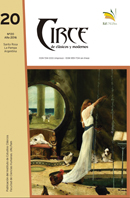The Reception of Plato’s Phaedo in Philo of Alexandria
Keywords:
Plato, Phaedo, Philo, soul, bodyAbstract
The knowledge and use of the Phaedo by Philo is an important source of information about its interpretation at that time. We must take into account that Philo never makes any direct references to the Phaedo but does quote a few snippets. However, Plato’s use of language has influenced Philo, particularly in the rich use of compound adjectives. Philo draws a copi-ous harvest of images from the dialogue: a) the image of the body as a prison; b) the image of the body as a garment for the soul; c) the bondage that the soul must endure through its association with the body; and d) the journey abroad (ἀποδημία) to another place (Phaedo67c), which is linked to the biblical theme of migration. Other general themes in the dialogue are also explored, such as the descent of the soul into the body in terms of metempsychosis or reincarnation. Finally, four passages are discussed: Leg. 1. 105-108, Gig. 13-15, Somn. 1. 138-139 and Her. 267-276.
Downloads
Downloads
Published
Issue
Section
License
Los autores que tengan publicaciones con esta revista, aceptan los términos siguientes referidos a los derechos de autor/a:
1. Los autores/as conservarán sus derechos de autor y garantizarán a la revista el derecho de primera publicación de su obra, el cuál estará simultáneamente sujeto a la Licencia de reconocimiento de Licencia Creative Commons Atribución-NoComercial-CompartirIgual 4.0 Internacional (http://creativecommons.org/licenses/by-nc-sa/4.0/). que permite a terceros compartir la obra siempre que se indique su autor y su primera publicación esta revista. El autor es el titular del copyright.
2. Los autores/as podrán adoptar otros acuerdos de licencia no exclusiva de distribución de la versión de la obra publicada (postprint) siempre que se indique la publicación inicial en esta revista. La cesión de derechos no exclusivos implica también la autorización por parte de los autores para que el trabajo sea depositado en el repositorio institucional y difundido a través de las bases de datos que el editor considere adecuadas para su indización, con miras a incrementar la visibilidad de la publicación y de sus autores.
3. Se permite y recomienda a los autores/as difundir su obra a través de Internet antes y durante el proceso de envío, lo cual puede producir intercambios interesantes y aumentar las citas de la obra publicada.







.jpg)









2.png)



